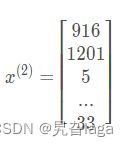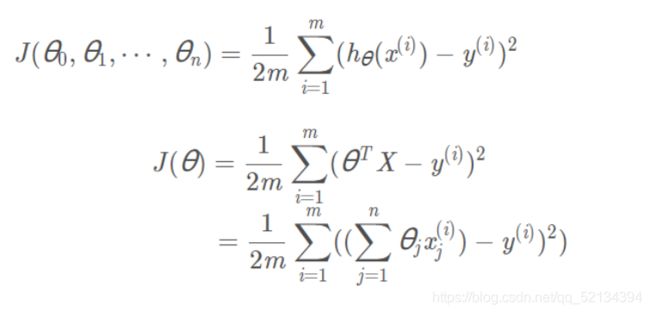多元线性回归
1.定义数据
第二行:
第二行第一列的数字可以写成:
2.定义函数
设置一个回归方程:
上角标T表示x0 矩阵的倒置,就是由行到列变为由列到行,使得其满足矩阵乘法的要求。
(2)添加一个列向量:
既不会影响到方程的结果,而且使x与θ \thetaθ的数量一致以便于矩阵计算。
为了方便表达,分别记为:
方程再次变形:
损失方程为:
3.鸢尾花数据集
import pandas as pd
import numpy as np
import time
import random
def MGD_train(X, y, alpha=0.0001, maxIter=1000, theta_old=None):
'''
MGD训练线性回归
传入:
X : 已知数据
y : 标签
alpha : 学习率
maxIter : 总迭代次数
返回:
theta : 权重参数
'''
# 初始化权重参数
theta = np.ones(shape=(X.shape[1],))
if not theta_old is None:
# 假装是断点续训练
theta = theta_old.copy()
# axis=1 表示横轴,方向从左到右;axis=0 表示纵轴,方向从上到下
for i in range(maxIter):
# 预测
y_pred = np.sum(X * theta, axis=1)
# 全部数据得到的梯度
gradient = np.average((y - y_pred).reshape(-1, 1) * X, axis=0)
# 更新学习率
theta += alpha * gradient
return theta
def SGD_train(X, y, alpha=0.0001, maxIter=1000, theta_old=None):
'''
SGD训练线性回归
传入:
X : 已知数据
y : 标签
alpha : 学习率
maxIter : 总迭代次数
返回:
theta : 权重参数
'''
# 初始化权重参数
theta = np.ones(shape=(X.shape[1],))
if not theta_old is None:
# 假装是断点续训练
theta = theta_old.copy()
# 数据数量
data_length = X.shape[0]
for i in range(maxIter):
# 随机选择一个数据
index = np.random.randint(0, data_length)
# 预测
y_pred = np.sum(X[index, :] * theta)
# 一条数据得到的梯度
gradient = (y[index] - y_pred) * X[index, :]
# 更新学习率
theta += alpha * gradient
return theta
def MBGD_train(X, y, alpha=0.0001, maxIter=1000, batch_size=10, theta_old=None):
'''
MBGD训练线性回归
传入:
X : 已知数据
y : 标签
alpha : 学习率
maxIter : 总迭代次数
batch_size : 没一轮喂入的数据数
返回:
theta : 权重参数
'''
# 初始化权重参数
theta = np.ones(shape=(X.shape[1],))
if not theta_old is None:
# 假装是断点续训练
theta = theta_old.copy()
# 所有数据的集合
all_data = np.concatenate([X, y.reshape(-1, 1)], axis=1)
for i in range(maxIter):
# 从全部数据里选 batch_size 个 item
X_batch_size = np.array(random.choices(all_data, k=batch_size))
# 重新给 X, y 赋值
X_new = X_batch_size[:, :-1]
y_new = X_batch_size[:, -1]
# 将数据喂入,更新 theta
theta = MGD_train(X_new, y_new, alpha=0.0001, maxIter=1, theta_old=theta)
return theta
def GD_predict(X, theta):
'''
用于预测的函数
传入:
X : 数据
theta : 权重
返回:
y_pred: 预测向量
'''
y_pred = np.sum(theta * X, axis=1)
# 实数域空间 -> 离散三值空间,则需要四舍五入
y_pred = (y_pred + 0.5).astype(int)
return y_pred
def calc_accuracy(y, y_pred):
'''
计算准确率
传入:
y : 标签
y_pred : 预测值
返回:
accuracy : 准确率
'''
return np.average(y == y_pred) * 100
# 读取数据
iris_raw_data = pd.read_csv('iris.data', names =['sepal length', 'sepal width', 'petal length', 'petal width', 'class'])
# 将三种类型映射成整数
Iris_dir = {'Iris-setosa': 1, 'Iris-versicolor': 2, 'Iris-virginica': 3}
iris_raw_data['class'] = iris_raw_data['class'].apply(lambda x:Iris_dir[x])
# 训练数据 X
iris_data = iris_raw_data.values[:, :-1]
# 标签 y
y = iris_raw_data.values[:, -1]
# 用 MGD 训练的参数
start = time.time()
theta_MGD = MGD_train(iris_data, y)
run_time = time.time() - start
y_pred_MGD = GD_predict(iris_data, theta_MGD)
print("MGD训练1000轮得到的准确率{:.2f}% 运行时间是{:.2f}s".format(calc_accuracy(y, y_pred_MGD), run_time))
# 用 SGD 训练的参数
start = time.time()
theta_SGD = SGD_train(iris_data, y)
run_time = time.time() - start
y_pred_SGD = GD_predict(iris_data, theta_SGD)
print("SGD训练1000轮得到的准确率{:.2f}% 运行时间是{:.2f}s".format(calc_accuracy(y, y_pred_SGD), run_time))
# 用 MBGD 训练的参数
start = time.time()
theta_MBGD = MBGD_train(iris_data, y)
run_time = time.time() - start
y_pred_MBGD = GD_predict(iris_data, theta_MBGD)
print("MBGD训练1000轮得到的准确率{:.2f}% 运行时间是{:.2f}s".format(calc_accuracy(y, y_pred_MBGD), run_time))





